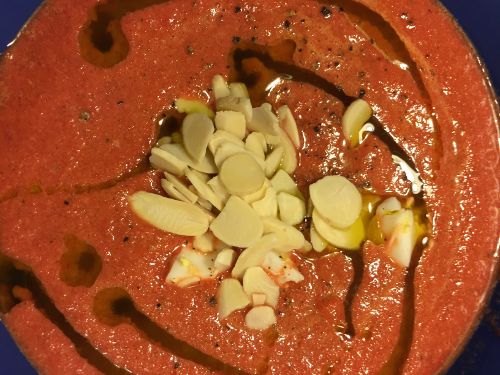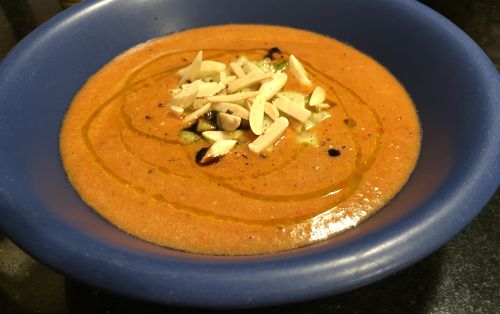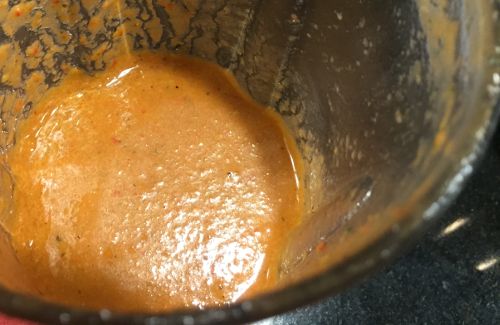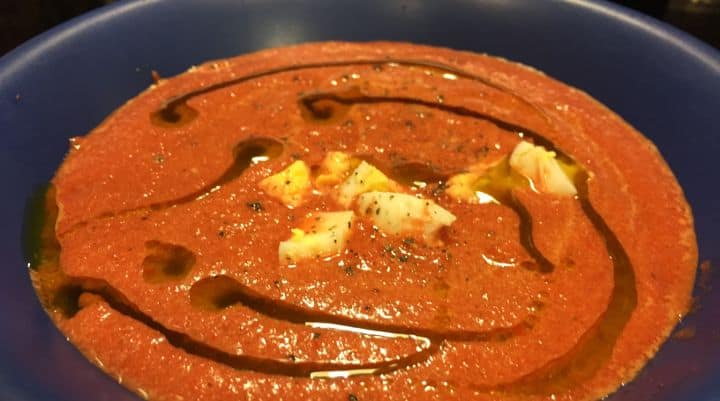
The whole world seems to be on a smoothie kick but I must admit I’m not the biggest fan! I don’t have much of a sweet tooth, so drinking thick, fruity liquid just doesn’t have the biggest appeal to me.
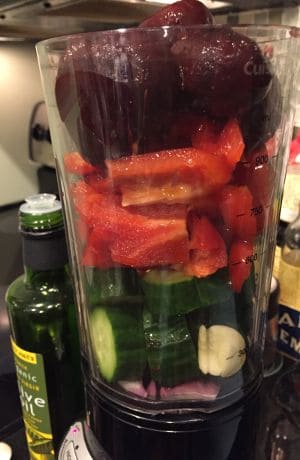
However, I recently figured out that I love soup. Even more so, as the weather warms up, I love gazpacho. Technically it’s a soup, but it’s like a vegetable smoothie! Actually it’s very much like a salad in soup form!
The beauty of gazpacho is that there’s no cooking involved, especially when it is hot. There’s a little prep work but even that is minimal. The best part of gazpacho is its versatility.
I dig the traditional gazpacho but most of the time, I just throw in whatever produce that is in the fridge. Most gazpachos are thickened with bread, but with the use of a hand or regular blender and lots of good quality olive oil (don’t skimp on this), I have never missed the bread. The result is very thick and “creamy” but healthier.
We cover the following....
Paleo Beet Gazpacho Soup Recipe (my absolute favorite)
- 4 medium beets, steamed (I use Love Beets Organic Cooked Beets – it’s in a vacuumed sealed pouch in the produce aisle at my grocer that contains nothing but organic beets, save the beet juice from the package)
- 1 red bell pepper, cored, deseeded and roughly diced
- 1 large cucumber, peeled and roughly sliced
- 1/2 small red onion or 2 small shallots, peeled and roughly diced
- 1 handful of grape or cherry tomatoes (optional)
- 1 clove garlic, peeled
- 1 tablespoon red wine or sherry vinegar (we often use red wine vinegar as a substitute for sherry vinegar in gazpacho)
- Salt and pepper
- 1/3-1/2 cup good quality, extra-virgin olive oil
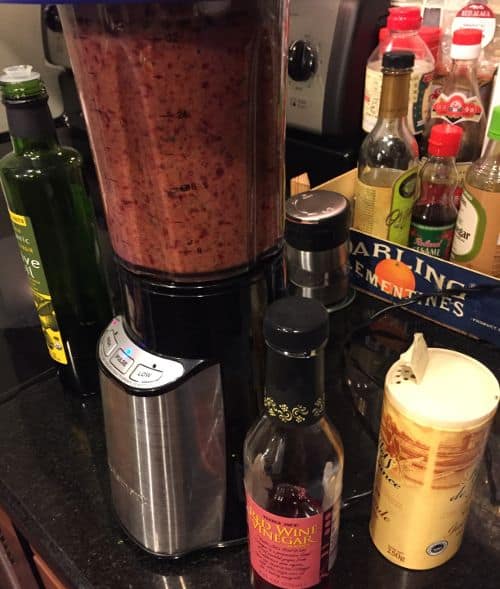
Unless using precooked beets (we often use organic french packaged beets on a work night when we are short on time), boil a pot of 1-inch of water and add the beets. Cook on low heat for 30-40 minutes (when you can easily pierce the beets with a knife). Cool and peel the beets. Reserve the water. You can also save some time making beets in the Instapot.
Place all the ingredients except the olive oil into a blender or deep bowl. Blend (or use a hand blender) until all the vegetables are pureed. If it’s too thick, use a small amount of the beet juice or cooking liquid (1-2 tablespoons at a time) to loosen the mixture. Taste and adjust the seasonings (vinegar, salt, pepper, garlic) Once all pureed, keep the blender on while drizzling in all the olive oil until the soup is emulsified and is thick and “creamy.” Serve immediately but even better to refrigerate for a few hours before serving. Garnish (see suggestions below) and serve in a bowl or cup.
Garnish Suggestions
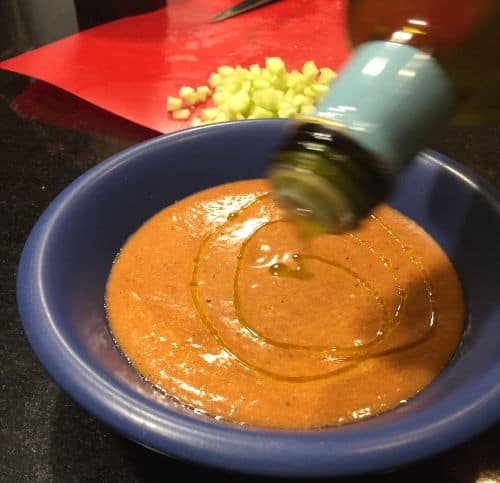
Adding some variety to the texture of the soup by adding cubed garnishes can really elevate the experience. If you are looking for something more along the lines of paleo chunky gazpacho, you might want to focus on some of the cubed vegetables, eggs, nuts or seafood mentioned below.
- Drizzle of good quality, extra-virgin olive oil (in my opinion, necessary!)
- Drizzle of aged balsamic vinegar
- Sliced toasted almonds
- Cubed cucumbers
- Chopped hard-boiled egg
- Sliced avocado
- Fresh chopped herbs
- Steamed or poached seafood (shrimp, crabmeat)
Other Paleo Gazpacho Variations we love:
Although we have been recently focusing on our AIP meal plan delivery series and our city guides like our Paleo meal delivery in Raleigh NC, Paleo meal delivery in Melbourne FL and Paleo meal delivery Tampa Florida city guides, we also love to share recipes we make all the time that have made our lives easier and better. Going grain, sugar and gluten free can be delicious!
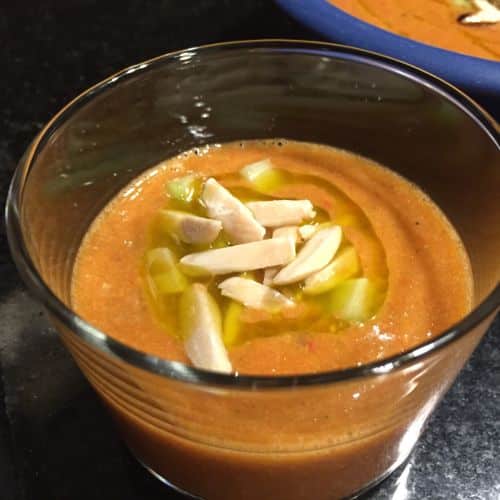
Paleo Classic Gazpacho Soup Recipe
Sometimes you just want a classic – this tomato focused Gazpacho soup is our choice during the tomato harvest season where the tomatoes are delicious on their own just sliced with salt.
- 6-8 ripe tomatoes, cored and roughly diced
- 1 bell pepper, cored, deseeded and roughly diced (my favorite is red bell pepper but any would do)
- 1 large cucumber, peeled and roughly sliced
- 1/2 small red onion or 2 small shallots, peeled and roughly diced
- 1 clove garlic, peeled
- 1 tablespoon red wine or sherry vinegar
- Salt and pepper
- 1/3-1/2 cup good quality, extra-virgin olive oil
Place all the ingredients except the olive oil into a blender or deep bowl. Blend (or use a hand blender) until all the vegetables are pureed. If it’s too thick, use a small amount of ice cold water (1-2 tablespoons at a time) to loosen the mixture. Taste and adjust the seasonings (vinegar, salt, pepper, garlic) Once all pureed, keep the blender on while drizzling in all the olive oil until the soup is emulsified and is thick and “creamy.” Serve immediately but even better to refrigerate for a few hours before serving. Garnish (see suggestions below) and serve in a bowl or cup.
Paleo Red Pepper Gazpacho Soup Recipe
To add a little sweetness in the winter time, a great option is to add some crisp organic red peppers to the gazpacho which really brightens up the flavor.
- Use 4-6 large red bell peppers
- 1-2 ripe tomatoes, or omit tomatoes altogether.
- 1 large cucumber, peeled and roughly sliced
- 1/2 small red onion or 2 small shallots, peeled and roughly diced
- 1 clove garlic, peeled
- 1 tablespoon red wine or sherry vinegar
- Salt and pepper
- 1/3-1/2 cup good quality, extra-virgin olive oil
Same recipe as above except first two ingredients. Use 4-6 large red bell peppers and 1-2 ripe tomatoes, or omit tomatoes altogether.
How long does it take to make gazpacho?
The beauty of these recipes is that you can have gazpacho made and ready to serve within 5-10 minutes, about the same amount of time required to throw together a quick salad. You simply wash and loosely chop the ingredients to be able to fit them in the blender, then blend everything as you add vinegars and seasoning to taste. We often don’t take the step of peeling tomatoes, peppers or cucumbers if we are in a hurry on a typical weeknight. The soup is still delicious. If you are able to chill the soup in the refrigerator for an hour or two before serving it will be at it’s most refreshing, but even using ingredients that were previously refrigerated will often yield soup that is slightly chilled.
Hopefully you take these as recipe starters and have fun with your own variations! It’s fun to try different vegetable combinations and spices to make different flavor profiles.
The best gazpacho recipe in the world can often be the simplest. After learning how to make gazpacho cold soup and realizing how easy it is, we tend to eat variations of it a lot all summer long, taking advantage of delicious in-season produce. Gazpacho is definitely one of the best recipes for cold soups for summer.
If you have a suggestion for another gazpacho recipe that would be a great addition to this list, please let us know in the comments below.

